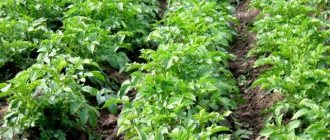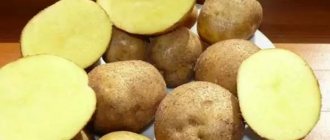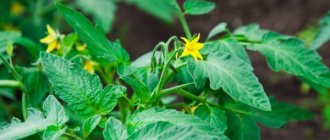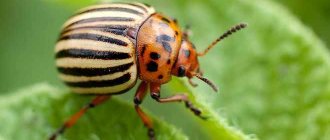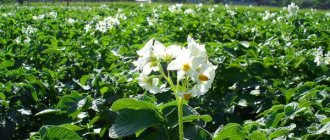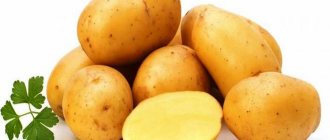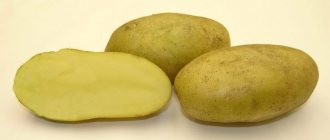Potatoes remain firmly in the forefront of familiar and most commonly consumed products. Over the long history of the appearance of this vegetable on the European continent, through the efforts of breeders, many varieties have been created.
Particular attention should be paid to the early-ripening Leader potato, which was created through selection by employees of the State Scientific Institution of the Ural Research Institute of Agriculture as a table variety, and included in the register for the West Siberian region. Later, the patent for the Leader variety was purchased by Agro.
Story
The leader is a table potato variety (Solanum tuberosum) of early ripening.
Received by specialists from the State Scientific Institution “Ural Research Institute of Agriculture”. The patent holder is Agrofirma Sedek LLC. In 2002, it was included in the state register of breeding achievements of the Russian Federation. Approved for cultivation in three regions of the country: Ural, West Siberian, Far Eastern. It is valued for its early ripening, high yield of marketable tubers and their excellent taste. Suitable for mechanical cleaning, transportation and long-term storage.
How to store
To ensure crop storage for the winter without loss, it is necessary to create optimal conditions. Usually a cold basement or cellar is used as storage.
The following parameters must be maintained in the room:
- temperature in the range +2-4° C;
- humidity 75-85%;
- blackout;
- air exchange.
The tubers themselves need to be prepared for storage. They are dried and then sorted, removing diseased and damaged specimens. If all conditions are met, early potato varieties can be stored for 3.5-4 months. The leader lies well in winter due to the fact that its peel is characterized by increased density.
Description and characteristics
Potato Leader has established itself as an unpretentious and high-yielding early-ripening variety. It is most common in Russia, Ukraine and Moldova. Main characteristics of the Leader variety:
| Requests | Characteristic |
| Roots | |
| Tuber | Oval-round |
| Peel | Yellow, smooth |
| Eyes | Small |
| Pulp | White |
| Weight | 88-119 g |
| Starch content | 12–12,2% |
| Plant | |
| Bush | Semi-erect, intermediate type |
| Top height | Medium, reaches 1 m |
| Sheet | Medium size, green, intermediate, little or no edge wavy |
| whisk | White, medium size |
Potatoes of this variety are propagated by tubers or parts thereof. The bush does not grow to the sides, and the tubers form and form together.
The leader has high yields, the highest were achieved in the Tyumen region - 339 c/ha.
The Leader variety is used for industrial and table needs. Starch and chips are made from it; it is used to prepare both the simplest dishes and complex ones that can satisfy the taste of the most demanding gourmet.
How to grow this variety
Potatoes are planted in the usual way or with seeds using conventional agrotechnical practices.
When planting seeds, take into account the following features:
- to increase the percentage of germination, before planting in the ground, the seeds are soaked for several days in a damp cloth;
- then the seeds are hardened by placing them in the refrigerator at a temperature of +1°C for 12 hours, then left at room temperature for another 12 hours;
- planted 80 days before planting in the garden;
- for planting seed material, select highly fertile loose soil, preferably on the sunny side of the site;
- the seeds are laid out on the surface of the soil without being buried;
- cover the bed with the sown seeds and leave for 1-2 weeks until the seeds germinate;
- Periodically, the seeds are watered from a small watering can.
Dates, scheme and rules of planting
Planting times depend on the planting method. If the material is prepared in advance, the seeds are sown in late March - early April. Tubers are sent into the ground from late April to mid-May.
With the tuberous method, the material is placed in a bright, warm place for germination 1-1.5 weeks before planting. During the germination process, tubers with weak, black sprouts are selected - they are unsuitable for planting. Immediately before planting in the ground, the tubers are treated with a fungicide solution for additional protection against diseases and pests.
At the time of planting, make sure that the threat of night frosts has passed. Daytime temperature should be 15°C, night temperature +4°C. The optimal temperature of soil heated to a depth of 50 cm is +7...+10°C.
Holes are dug at a distance of 35-40 cm deep by one bayonet of a shovel, humus is placed on the bottom and 1 liter of warm water is poured in. The tubers are placed in the holes with the sprouts facing down. The distance between rows is 60-70 cm.
Care
When the root system is being established, the garden is not watered. Later, watering is carried out regularly between the rows, increasing at the time of flowering and stopping before harvesting.
In between waterings, to improve air exchange and the formation of large, high-quality tubers, the soil is loosened and weeded. Do not allow the bed to become overgrown with weeds, since with a more developed root system and high growth vigor they are able to choke out the potato bushes, taking nutrients and moisture for themselves.
Hilling or mulching is carried out several times during the growing season. Hilling is the formation of high ridges of earth around each potato bush. Mulching is covering the soil around the bushes with a layer of grass, sawdust, and straw. Mulching makes it possible to do without weeding and hilling and maintains the level of moisture in the soil.
Nuances of cultivation and possible difficulties, diseases and pests
Potatoes are not planted in holes and other depressions, since excess moisture leads to putrefactive processes. The soil chosen is well aerated, with sufficient oxygen content. Krasa loves abundant watering and responds to it with a high yield.
Fertilizing is carried out several times per season, using mineral and organic fertilizers:
- chicken manure is diluted with water in a ratio of 1:15 and placed in a warm place for 2-3 days, watered 1 liter per bush;
- ash - up to 10 kg per hundred square meters;
- urea or ammonium nitrate;
- ammophoska.
The variety is known for its resistance to most known diseases at the genetic level, so preventive work is rarely carried out. However, if seed material was used of inadequate quality and crop rotation conditions were not observed, the likelihood of diseases increases.
Apply:
- from scab - “Maxim or “Ditan”;
- for late blight - “Ridomil” or “Agate”;
- for Alternaria - 1% Bordeaux mixture, a course of 4 times a week.
Rarely attacked by pests, if this does happen, the bushes are treated with insecticides or fungicides:
- from the Colorado potato beetle - “Iskra”, “Aktara”;
- from caterpillars - “Danadim”, “Zolon”;
- from mole crickets - “Medvetox”, “Medvetsid”.
Description and characteristics of the variety
The Leader potato was obtained thanks to the fruitful work of the employees of the State Scientific Institution of the Ural Scientific Research Institute of Agriculture and was included in the State Register of Russia in the early 2000s. The variety is early ripening and has a lot of advantages, among which high taste characteristics and productivity, suitability for transportation and a long storage period are especially valued.
Did you know? During the Alaska Gold Rush, potatoes, which protected against scurvy, were worth more than gold.
Plants and fruit
The Leader tuber has an oval or oval-round shape, the weight of which can reach 100–120 g. The color of the peel is yellow, the flesh is white. The eyes are small and shallow, which is very valuable when cleaning. One bush contains about 7–10 tubers.
Thanks to its high taste characteristics, Leader is suitable for any dish - fried, boiled, baked and other types. The tops of this variety are quite tall and developed - up to 1 m in height. The dark green leaves are small in size and have some wavy edges. The color of the corolla is white.
Ripening time
Leader is an early ripening variety. The full ripening period for these potatoes takes 65–75 days, and the first coping is available already on the 45th day after the seedlings hatch.
Productivity
The Leader variety has a fairly high yield, which is about 207–250 c/ha. At the same time, the maximum recorded indicator reached 340 c/ha. Depending on the stages of the growing season, the yield level also changes slightly:
- at the time of the first digging (day 45) - 98–115 c/ha;
- in the second digging (day 55) - 135–188 c/ha.
The variety exhibits high protection against cancer pathogens, but is easily susceptible to late blight, which affects both tubers and potato tops
World leaders in potato growing
Since potatoes are the second bread that is grown all over the world, and today we are talking about a variety with the loud name “Leader,” the reader will be interested to know about the leading countries in potato production.
Researchers have announced the top 10.
10th place – Poland. This country harvests 6.33 million tons per year. Previously, these figures were much higher, and Poland deservedly took second position in the ranking. But this was at a time when pigs were actively bred in the country and they needed to be fed with something.
Potatoes were the main food for these farm animals. Unfortunately, agriculture is not held in high esteem here now, so potatoes are grown only for human needs.
9th place – the Netherlands. The Dutch harvest 6.80 million tons of potatoes per year. Most of it is grown exclusively for processing at local enterprises. But this country is considered the main supplier of seed potatoes of various varieties.
In the Netherlands, rather modest areas are allocated for potato fields, but thanks to competent agricultural technology, the crop yield is recognized as the highest in the world.
8th place – France. The French are also leaders in potato production, harvesting as much as 6.98 million tons of tubers per year. Although recently the domestic consumption of this product has decreased slightly, compared to some other vegetable crops, potatoes continue to be in demand here.
7th place – Bangladesh. Potatoes are loved in this country, as evidenced by the annual harvest of 8.60 million tons. Bangladesh has skyrocketed in the rankings due to its high population density. Potatoes are one of the staple foods for its residents.
6th place – Germany. 9.67 million tons of potatoes are harvested here every year. When the vegetable arrived in this country, it was used only as animal feed. But 1770 changed everything; tasty tubers entered the German diet forever. Now many fields are devoted to the crop, and its use has expanded significantly.
5th place - USA. American farmers grow 19.84 million tons per season. Approximately half of the harvested crop is consumed as food, processed into starch, used as animal feed, and used to produce chips and other products.
Everything else is exported. Idaho is the leading US state in potatoes. Washington is "breathing down his neck." Potatoes grown in these states are sold to Mexico, Canada, Japan and some other countries.
4th place – Ukraine. Ukrainians grow approximately 22.26 million tons of potatoes per year. Here it is one of the most important food products, which is confirmed by statistics. According to research, over the course of a year, one resident of the country eats up to 136 kg of potatoes.
A large percentage of the harvest goes to factories for the production of alcohol and starch. Some of the tubers are sold to large distributors. Chernozems predominate in Ukraine, so the vegetable yield here is very high.
3rd place – Russian Federation. We harvest up to 30.20 million tons of potatoes. Agricultural enterprises specializing in it operate throughout the country and produce 13% of the total harvest.
Almost 80% is owned by private owners. Most gardeners grow potatoes for personal consumption, while the rest sell tubers to farms.
2nd place – India. This country produces 45.34 million tons of potatoes per year. The potato industry in India is growing very quickly, hence the high figures. The vegetable is cultivated mainly by small farms located in the western part of the country. This is where the optimal conditions for growing this crop are.
1st place – China. This is a leading country in potato harvesting. The Chinese annually collect up to 88.99 million tons of product. This love for potatoes can be explained by the fact that the Chinese government is interested in growing it, because this vegetable brings more profit than legumes and grains.
Approximately 85% of the total harvest is consumed by the population, and the remaining 15% is used to produce chips and frozen French fries. The crop is grown in the western and northern regions of the country, mainly on large farmland. Its productivity here is not very high, but this does not in the least hinder China from being a leader.
okartoshke.ru
Pros and cons of the Leader variety
Like all varieties, Leader potatoes have both advantages and disadvantages.
Advantages of the variety:
- high taste qualities;
- wide range of uses;
- high level of productivity, regardless of weather conditions;
- stable immunity to various diseases;
- high transportability and keeping quality.
Minuses:
- vulnerability of the variety to pest invasion;
- low drought resistance;
- high need for hilling.
Advantages and disadvantages
Leader potatoes have many advantages, which sets them apart from numerous table varieties. The disadvantages of potatoes in comparison with its positive qualities are insignificant.
| Advantages | Flaws |
| Wide range of uses | Vulnerability to pests (Colorado beetle, nematode, wireworm and mole cricket) |
| High yield | Lack of moisture negatively affects the harvest |
| Multituberism | Hilling requirement |
| Disease resistance | |
| Good transportability | |
| High taste qualities | |
| Long-lasting shelf life of tubers |
Landing
It is best to prepare Leader potatoes for planting during the harvesting process. The main criteria for choosing planting material:
- medium size potatoes;
- a large number of eyes;
- healthy, undamaged tuber.
It is advisable to turn the tubers green by keeping them in a lighted place for some time, this protects them from rodents and pests. Store potatoes at a temperature of 11-16C°.
Important! The choice of small tubers for planting leads to low yield and extinction of the variety.
Before planting, Leader potatoes are germinated. The process lasts about a month. There are several ways to do this:
- the tubers are laid out on the floor;
- potatoes are sprouted in sawdust;
- planting material is placed in plastic bags with ventilation holes;
- tubers are placed in wooden boxes.
Sprouted tubers are planted in open ground at the end of early May. The planting pattern is 60x35 cm, planted to a depth of 8-15 cm. If the soil is loose, the planting depth increases to 20 cm.
Ash is a good fertilizer for Leader potatoes. It can be added to the soil in the fall, or you can sprinkle it on the tubers when planting. Planting Leader potatoes is recommended on land where winter crops, perennial grasses or flax previously grew.
Important! When fertilizing, it is better not to use fresh manure. It can become the causative agent of many potato diseases.
Pest Control
To get a good harvest of high-quality potatoes, you need to take care of protecting the plant from various kinds of negative influences, primarily from the Colorado potato beetle, which can destroy it in a matter of days.
The control process can begin at the time of planting by adding onion peels to the holes or treating the tubers with special products that will help protect them.
Many summer residents refuse to use chemicals and use folk remedies. For example, legumes are planted along the perimeter of a garden plot, and calendula is planted between potato bushes.
If these actions do not lead to the desired result in the fight against the Colorado potato beetle, then you still need to use store-bought products. Prestige and Bordeaux mixture received excellent reviews from users.
Another pest of potatoes is the wireworm, which is often confused with an ordinary earthworm. Its larvae are capable of infecting tubers, which in the future will not be able to be stored for a long period of time. Affected tubers rot very quickly.
Root vegetables are also affected by the mole cricket, which gnaws right through potatoes. To protect the fruits of the plant, both traditional methods and chemical preparations can be used. Among the many different folk methods, the simplest is the preparation of a soap solution, which is poured into the place where the mole cricket enters or exits the ground.
Traps made of glass jars, which are dug along the pest’s tunnel, have proven themselves to be excellent. You can also use bait made from honey or beer, the scent of which attracts mole crickets.
Potatoes of the “Leader” variety are well-deservedly popular among Russian gardeners due to their high yield, excellent taste and nutritional qualities, and ease of care.
eda-land.ru
Care
The Leader variety is unpretentious, but you still need to follow the basic rules of care:
- watering;
- hilling;
- feeding
Watering potatoes Leader depends on the region. In areas where summers are hot and dry, watering is done once a week; in areas with more moderate climatic conditions, once a month will be sufficient.
Leader potatoes experience the greatest need for moisture before flowering and directly during the flowering process.
Hilling and feeding
Hilling is no less important than watering. It consists of shoveling soil from the rows onto a potato bush. The process is carried out after watering or rain, it is important that the soil is moist, this forces the tubers to sprout new underground shoots, on which the crop is formed.
Such manipulations also protect the Leader’s seedlings from frosts, which often occur in May. The hilling procedure is usually carried out twice:
- when the height of the bush reaches 13-17 cm;
- before flowering potato bushes.
The Leader variety can do without fertilizers, but if the soil is poor, then it is better to feed it.
| Deadlines | Fertilizer |
| The appearance of the first leaves | Mullein or bird droppings solution |
| Potato flowering period | Urea or ash solution |
| A month before digging up the tubers | Foliar fertilizing with superphosphate |
Features of cultivation
Knowing all the features of growing potatoes and adhering to the basic rules for choosing a place and planting procedures for this vegetable are decisive factors in obtaining a rich and high-quality harvest.
We recommend reading about preparing potatoes for planting.
Growing conditions
The general process of growing potatoes is based on several basic conditions:
- Temperature regime . Despite the fact that potatoes are grown in different regions with different climatic conditions, the most optimal growth conditions for this vegetable are cool summers. It should be taken into account that the air temperature at night has the strongest influence on growing potatoes during the period of no seedlings, and then the daytime temperature. According to research by potato scientists, the suitable soil temperature at which active growth and development of tubers of early ripening varieties, such as Leader, occurs is +11...+15°C for the northern regions and +15...+17°C for the southern regions. Elevated temperatures (from +25°C) negatively affect the development of tubers, and in special cases (+30°C and above) cause plant growth to stop. Low temperatures also act as unfavorable conditions - the tops are damaged at -1.5...-2°C, and the tubers themselves - at -2...-3°C.
- Soil moisture . The stages of sprout formation and the first formation of tops have practically no need for moisture. During this period, the plant also easily tolerates elevated air temperatures. Increasing soil moisture becomes necessary during the flowering period and until the end of tops growth - at this stage, an insufficient amount of moisture can lead to leaf wilting and a failure in the process of starch accumulation in the vegetable. A period of prolonged drought causes a decrease in the amount of yield and a deterioration in the taste characteristics of potatoes. However, it is worth taking into account that excessive watering also negatively affects the general condition of the plant and leads to oxygen starvation (the main sign of oxygen deficiency is the growth of white lentils over the entire surface of the potato).
- Lighting . The consequences of a lack of this factor are elongated stems, yellowed tops and a delay in the formation of tubers. Lighting is useful for dug up seed potatoes - after being exposed to light, they acquire a green tint, which indicates the formation of chlorophyll. Such planting material is protected from damage by various viral diseases and rodent attacks during storage. You need to know that ware potatoes should be stored in dark rooms, because after greening, solanine is formed in it, which has toxic properties and makes the vegetable unsuitable for consumption.
- The soil . Growing potatoes requires loose, loose and non-salty soil, in which the tubers develop well and are not deformed. The best option would be sandy and loamy chernozems. Potatoes will also grow in infertile soil, but this will negatively affect the final yield.
The choice of small tubers for planting leads to low yield and extinction of the variety
Landing dates
There is an established tradition of planting potatoes in the first half of May, but such dates are not always correct. Since potatoes are a heat-loving crop, they require planting in already sufficiently warmed soil - haste can lead to loss or destruction of the crop. Another important factor is soil moisture: high levels can cause the formation of rotten diseases.
It is not difficult to independently determine the optimal timing for planting potatoes. To do this, you should wait until the spring frosts have passed and the ground has warmed up to at least +8°C to a depth of 10–12 cm. When predicting the planting period, you can analyze the weather forecast from several sources for the expected date of planting potatoes, or use folk signs: between the bird cherry flowering and It takes about 7–10 days for foliage to appear on a birch tree. This period is considered the most suitable.
Important! Many gardeners take into account the lunar calendar when planting, but the influence of the moon on the growth of planted plants has not been scientifically confirmed.
Selection and preparation of a landing site
When choosing a site, you should take into account that the place for planting potatoes should be flat, open and not shaded - this crop requires sufficient natural light. The soil must have a topsoil and a high humus content. To prevent various diseases, it is recommended to use crop rotation. Legumes and winter grain crops are considered the best predecessors for potatoes, but in general you can plant any vegetables except nightshades (tomatoes, peppers, eggplants and others). The use of crop rotation leads to the restoration of nutrients in the soil, as well as its purification from various pests and pathogens.
The soil intended for planting is prepared in the autumn - plowed (to a depth of 25–30 cm), cleared of weeds and fertilized with complex organic and mineral fertilizers. With the onset of spring, fertilizing is applied to the soil again, but this time with nitrogen fertilizers.
Technology and planting scheme
Depending on the region and climatic conditions, there are many different technologies for planting potatoes. The most popular among them are:
- Planting in ridges - suitable for regions with regular and heavy rainfall. When using this scheme, the tubers will be located above ground level, which allows water to flow into the aisle without harming the potatoes. This technology is well suited for planting in clay soils, but requires frequent watering in sandy and sandy loam soils.
- Planting in trenches - the method is preferable for arid regions and consists of preparing special trenches into which organic matter (manure, compost, ash or hay) is first placed. This method of planting ensures constant maintenance of the desired level of moisture and no need for additional bait. However, planting in trenches is a rather labor-intensive process, and there is a risk of rotting in the event of prolonged rains.
- Planting in double beds - following this technology, potatoes are planted in holes that are arranged in a checkerboard pattern. This method provides more space for the development of the plant's root system and sufficient lighting for the tops, which has a positive effect on the quantity and quality of the future harvest.
- Planting using the Mittlider method maintains the most optimal conditions for the growth and development of potatoes and, despite the need for labor when first forming beds, subsequently significantly saves time and effort on weeding.
Despite the variety of different methods, the most popular method of planting potatoes among gardeners remains the technology of planting potatoes in rows, under a shovel:
- after digging and fertilizing the soil, mark the edges of future beds with stakes;
- dig holes at a distance of about 25–30 cm from each other and a depth of 7–10 cm for sandy loam soils, and 5–7 cm for loamy soils;
- Fertilizer and planting material are placed in each hole. At the same time, make sure that the fragile sprouts do not break;
- The hole is covered with earth.
The distance between rows is 70 cm, but can be reduced for early varieties if there is not enough space on the site.
Important! When reducing the distance between the rows, it should be taken into account that during the growth process the potatoes will need hilling, the soil for which is taken from the inter-row spaces. If they are too narrow, the root system may be damaged.
Diseases and pests
Leader potatoes are resistant to the most common diseases, such as dry rot, spotting, rhizoctonia, and blackleg. But Leader is quite susceptible to late blight.
To prevent disease, the soil is treated in advance with Bordeaux mixture; a solution of copper sulfate can also be used for these purposes, then the bed is dug up. Or they directly spray the Leader’s tubers themselves with preparations containing copper sulfate.
For a good potato harvest, Leader will have to fight pests.
| Pests | Fighting methods |
| Colorado beetle |
|
| Medvedka |
|
| Nematode |
|
| Wireworm |
|
Timely implementation of such preventive measures helps prevent not only the appearance of pests, but also many potato diseases:
- digging up soil;
- loosening the soil;
- weed removal;
- periodically changing the place where potatoes are planted;
- pre-treatment of planting material.
Harvesting and storage
Harvesting of Leader begins in the second half of July. Young potatoes can be dug up from mid-June. A clear, dry and windless day is chosen for collection. Before harvesting, the tops of the variety are cut off at the root - by this time more than 50% of it has already turned yellow and drooped.
The leader can be dug mechanically - the skin of the tubers is quite strong and is rarely damaged by agricultural technology. The skin on mature root vegetables is dense, does not peel or flake off. After digging, the tubers are laid out to dry in an open space for a day. After this, the Leader is sorted, removing the mis-graded and selecting whole, full-bodied tubers.
The harvest of the variety is stored in spacious, moderately cool, well-ventilated rooms: cellars, sheds, or basements. Before storing potatoes, they are treated with an antifungal drug such as Kagatnik. Storage temperature 5°-7°, humidity level – no more than 80%. The Leader is sorted at intervals of 21 days.
Advantages of the variety
The Leader variety quickly gained popularity among gardeners and farmers, thanks to a large number of advantages that distinguish it from most table varieties:
- The versatility of tubers. Due to the high starch content in the fruit (up to 12.2%), these potatoes are used both for table needs and for industrial use. Starch, chips, dry potato mixtures, etc. are prepared from Leader tubers. When boiled, it can be used as a filling for dumplings and pies, and is suitable for frying and making purees.
- High yield from one bush. With proper care and sufficient watering, 8 to 12 large tubers are harvested.
- Transportability and keeping quality of tubers. Thanks to its durable peel, these potatoes can be stored for a long time without losing their quality. During transportation, the tubers are not damaged, which allows you to transport the crop over long distances without the risk of losing part of the cargo.
- Disease resistance. This type of tuberous plant is resistant to most diseases: late blight, dry rot, blackleg, rhizoctonia, spotting.
Characteristics of Veneta potatoes
These are dessert potatoes - the result of the work of German breeders. It is well suited for farmers growing crops in regions with difficult climatic conditions. The drought resistance of the early ripening variety made it possible to plant it in Central Asia. The moisture-resistant quality of the fruit is suitable for the southern region. Fast ripening times are appropriate for the short Ural summer. Long shelf life makes it possible to grow the crop on a production scale.
Productivity
The priority characteristic of the Veneta potato variety for vegetable growers is not only the unpretentiousness of the crop in care, but also the simultaneous formation of 10 or more tubers in a bush. Harvesting in the southern regions is possible in two stages. The first harvest takes place in July, landing in mid-March. From 1 sq. m with proper cultivation of the soil, the harvest reaches 2.5 kg, about 60 days pass from the moment of planting. If a root crop is taken that has not reached full maturity (45 days after planting), the yield is 1.3 kg.
After harvesting, the plot is replanted with the “Veneta” variety. The next collection occurs at the end of September and amounts to 1 sq. m up to 2.2 kg. In temperate climates, the yield is the same; the plot is planted only once.
Resistance to diseases and pests
An important advantage of the variety, judging by the reviews, is that the “Veneta” potato is practically immune to fungal and bacterial infections:
- rotting of root crops;
- golden nematode;
- wrinkled mosaic;
- potato cancer.
The only disease that affects Veneta is late blight. It occurs infrequently and spreads only to the tops, without affecting the tubers. As with any potato variety, Veneta is parasitized by Colorado potato beetle larvae. There are sufficient remedies for this problem on the agrochemical market, so pest control is not essential.
Advantages and disadvantages of the variety
According to the characteristics and reviews of vegetable growers, the variety has no disadvantages. The following factors make Veneta potatoes attractive for cultivation both on private plots and on large farm areas:
- Early ripening time - 2.5 months from planting.
- The vegetable does not lose its taste when harvesting a young crop early (after 1.5 months).
- The culture is undemanding in care.
- High potato yield - up to 2.5 kg per 1 sq. m.
- Feels comfortable on any soil.
- Weather resistance - easily tolerates drought.
- Good taste.
- Maintains its shape during cooking.
- Long shelf life, virtually no waste.
- Resistant to mechanical damage, easily transported over long distances.
- Not susceptible to traditional cultural diseases.
- Does not require watering from the beginning of planting until harvest.
Preparing potato tubers for planting
It takes 30-35 days to germinate potatoes for planting. The best time to start preparing is in the summer, during harvest. One of the common mistakes is selecting seeds for potatoes that are too small. Because of this, the summer resident may obviously receive a low harvest. After all, bad specimens contribute to the extinction of the variety. When digging tubers, it is advisable to select the best, undamaged ones. It would not be a bad idea to green up the planting material in the fall. This will protect it from pests and rodents. You can do this by simply leaving the potatoes in the light.
If in the spring potatoes begin to germinate prematurely, then the shoots need to be broken off. Planting material should be stored at a temperature of 11 to 16 degrees. If the temperature is higher, the tubers will become sluggish and weak, and the sprouts will quickly elongate. Depending on the size of the cellar, seed potatoes are germinated:
- in wooden boxes;
- in plastic bags with ventilation;
- in sawdust;
- spread out on the floor.
The main condition is uniform light penetration. Germination accelerates in darkened rooms. The purpose of these actions is to bring all tubers to readiness for planting. This will help to achieve simultaneous germination and early harvest.
Carrot. Which variety should I choose?
Marina Mariam
“blunt-nosed, long, large, smooth and bright red” - this is the Children’s variety. On top of everything else, it is very sweet and super juicy. Nantes is also okay, but it’s orange and not as juicy compared to Children’s.
Elena Orlova
everything on the ground, for example, no one grows Nanskaya in a dacha village, even if it cracks, but hybrid varieties grow well for me, Canada, Nandrin, Samson, try Samson and Nandrin are blunt-nosed
Goldfish
I like Nantes. My neighbor next door buys manure every year. We usually plant carrots at the same time, she with manure, I with sand. In a month and a half we have a competition to see who has more, mine is not inferior at all, and there are even more
I liked the Queen of Autumn the most. Photos in my world.
Baikalochka
I always buy different names of carrots. Plant several varieties one year, choose according to your taste. The quality of the harvest also depends on proper care. If you live in the European part, then do not get carried away with HYBRID varieties of carrots.
I plant Nandrin, Pharaoh, Sweetheart, Samson
I liked the variety - Children's, very juicy and the Canada variety.
Nataly Sitko
This year I planted gourmet and sweet tooth for the first time—I initially thought that different producers called the same variety differently—no, they are different varieties—sweet tooth is less sweet than gourmand—sweet tooth is 2 times shorter and blunt-nosed—I also don’t like cone-shaped ones— but I liked the gourmet - it’s not a cone or blunt-nosed - it’s so tasty that it doesn’t matter what kind of nose it is - and it’s sooo long - the length of a spade bayonet
Elena Smirnova
I always sow Nantes, but this year my neighbor shared the already soaked seeds (she still had them). He always mixes seeds of different varieties and sows them in the same bed. Don’t ask why, I don’t know and haven’t gotten a clear answer. So, in this “mixed” bed the carrots turned out better than in the others.
The King of Autumn or the Queen of Autumn will suit your desire. I plant them. They grow 20-25 centimeters long. Although not very blunt-nosed. But orange. And this year my neighbor praised the Autumn Tale (one to one, although it’s not long).
KostyukovaCanes.
In 12, I planted a little and the small ones grew. I was very happy about everything. its for the first time. Now I bought carrots on a ribbon, red carrots without a core and the red giant (biotechnics) Russian size 30 cm grows. And polar carrots, round cranberries - these are northern vegetables (especially early and resistant) so I wrote out a lot..)) markings.
Yulia Sokolova
You need to plant zoned varieties of your region. Each region has its own carrots that will produce well.
I bought the carrots I liked at the market from the machine of an experienced seed farm in the spring of 3 years ago, planted them, and received the seeds. Now I’m just planting it, I don’t even know the name, because they told me they haven’t come up with the name yet, they bred it themselves. Sweet
Varieties of red potatoes with yellow flesh
It is difficult for every gardener to choose the right potato variety among the large number of varieties of yellow-fleshed vegetables. Below you can find the most popular varieties that are characterized by high yields.
Bellarosa (may be called Bella Rose or White Rose)
Bella Rosa is an early variety of vegetable crop, which is distinguished by pleasant taste characteristics and high yield levels.
The variety does not require systematic soil moisture. The crop variety can tolerate prolonged dry periods well. Root crops can be planted in any type of soil.
Agronomists recommend applying fertilizers to the soil, which will help increase the yield. White rose is not susceptible to nematodes and potato cancer.
Tubers tolerate transportation well over long distances. A significant advantage of potatoes is the lack of predisposition to overcooking, which allows the product to be used for preparing first courses, salads, French fries, and chips.
Condor
A mid-early variety of table potatoes. The shape of the tubers is long, oval.
The variety tolerates drought and can easily adapt to any climatic conditions.
The condor is not susceptible to late blight, potato blight, fusarium and common scab. The growing season is between 75-90 days.
Red Scarlet
An early variety of vegetable crop, which has an average yield and satisfactory taste. Red Scarlet should be grown in soil with good breathability.
It is advisable to select root crops with 5 eyes for planting. Even in the absence of frequent soil moisture and weeding, the yield level does not fall. The formation of red potato tubers with yellow pulp is simultaneous.
Red Scarlet is not susceptible to diseases such as potato canker, but is often affected by late blight. The pulp does not darken after removing the skin.
Red Scarlet
Rodrigue
The ripening period of the Rodrigue vegetable crop reaches 80 days. The mid-late variety of potatoes has a high yield level. With proper care, you can collect 400-500 centners of crop from each hectare.
The pulp can be colored white or yellow. The weight of each fruit is 700-800 g. The Rodrigue variety has no disadvantages. Gardeners can grow tubers in any climate.
Among the main advantages of the mid-late variety of potatoes, it is worth highlighting:
- the presence of a minimum number of eyes on root crops;
- the ability to use the crop to make French fries and chips;
- the commercial appearance of the tubers, which is achieved due to the dark red color of the potatoes.
